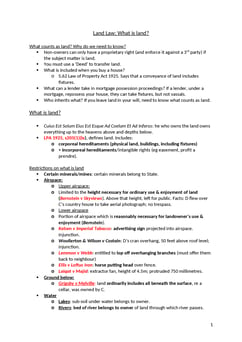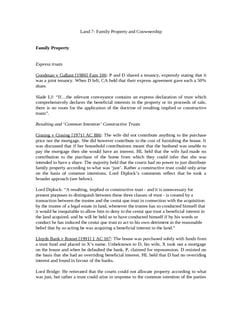Crest Nicholson v McAllister [2004] 1 WLR 2409
Judgement for the case Crest Nicholson v McAllister
Table Of Contents
KEY POINTS
It is clearly advantageous for a buyer of land subject to a restrictive covenant to not only be able to determine, through examination of the appropriate registry records, that the land is encumbered by such a covenant, but also to establish the specific land for which the covenant's advantages were obtained.
Purchasers of land burdened with restrictive covenants should be able to ascertain not only the existence of the covenants but also the parties entitled to enforce them, to ensure transparency and fairness.
FACTS
A piece of land near Claygate Common was sold for building purposes to the Mitchell brothers. They subsequently sold portions of the land to individual purchasers through various conveyances, which included restrictive covenants.
The proposed development land, which is the subject of the case, comprises parts of these conveyed properties. Crest Nicholson entered into a contract in 2000 to purchase the proposed development land for building new houses, while Mrs. McAllister opposed this development, claiming that it would breach the restrictive covenants benefiting her property.
COMMENTARY
The case highlighted the importance of clarity and precision in identifying the parties entitled to enforce restrictive covenants, as well as the practical implications for purchasers and developers dealing with covenanted land.
ORIGINAL ANALYSIS
The claimant failed in her efforts to enforce the covenant because the land intended to benefit could not be identified.
The court held that for Section 78 to assist, it must still be possible from the document imposing the covenant (if necessary with the aid of external evidence) to identify the land which was intended to benefit from the covenant.
The true effect of s.78 was to render it unnecessary to state in the conveyance that the covenant was to be enforceable by persons deriving title under the covenantee or his successors in title and by the owner or occupier of the land intended to be benefited, or that the covenant was to run with that land.
Chadwick LJ
It is obviously desirable that a purchaser of land burdened with a restrictive covenant should be able not only to ascertain, by inspection of the entries on the relevant register, that the land is so burdened, but also to ascertain the land for which the benefit of the covenant was taken-so that he can identify who can enforce the covenant.
For Further Study on Crest Nicholson v McAllister

A collection of the best GDL notes the director of Oxbridge Notes (an O...
Need instant answers? Our AI exam tutor is here to help.
Ask questions 🙋 Get answers 📔 It's simple 👁️👄👁️
Our AI is educated by the highest scoring students across all subjects and schools. Join hundreds of your peers today.
Get StartedSimilar Cases
Related Product Samples
These product samples contain the same concepts we cover in this case.
| GDL Land Law | Freehold Covenants Notes (14 pages) |
| GDL Land Law | Freehold Covenants 2 Notes (13 pages) |
| Land Law | Restrictive Covenants Notes (38 pages) |

 Since 2010, Oxbridge Notes has been a trusted education marketplace, supplying high-quality materials from top achievers at universities like Oxford, Cambridge, LSE, Harvard, and Yale.
Since 2010, Oxbridge Notes has been a trusted education marketplace, supplying high-quality materials from top achievers at universities like Oxford, Cambridge, LSE, Harvard, and Yale.